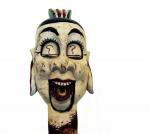What’s your story?
Share and find customer experiences
Connect with the people behind them
Wacktrap is
feedback made social
Trending Content
Money Takes Big Bucks Cocaine Coke Found on 90% U.S. Paper Currency Bills
by hearit
American money takes big bucks to produce: it's a cash business, with the U.S. Mint losing 22 million dollars in the Treasury's production of 2009 pennies and nickels. Another cash business, cocaine has a link to U.S. bills: traces of "coke" exist on 90 percent of U.S. paper currency bills.
The United States Mint spends 1.6 cents to make one cent, and six cents to make every nickel. The lowest denominations of U.S. currency, the penny and nickel, are the only forms of circulated money that are a cash loser for the Mint -- of either coins or bills -- actually losing more money in production costs than their face value. The larger the denomination, the larger the profit -- at least as far as coins are concerned: as of 2008, the United States Mint's invested 4.36 cents to make each U.S. dime in circulation, and the cost of the "almighty dollar" has proved worthwhile in making a buck: it costs the Mint only 29.6 cents fto make a "golden" dollar coin.
The better question, in terms of dollars, is just how much U.S. consumers actually lose on the minted coin pieces each year -- through mistaking the dollar coin pieces for the similarly-sized quarter.
Pennies made before 1982 are much more valuable than today's pennies -- most of the reason coming down to copper. Penny coins minted before 1982 are actually made of 95% copper, making value of the 1-cent pieces approximately 2.5 cents per penny. Pennies minted in roughly the past three decades are instead made of only 2.5% copper and 97.5% zinc -- yet still cost the United States Mint more to make than their circulated worth: The United States Mint lost 19.8 million dollars making the U.S. 1-cent pieces in 2009. The Mint also didn't "make a mint" on nickels, losing 2.2 million dollars on the 5-cent coins manufactured in 2009.
Five bucks has the shortest lifespan -- in the wallet and in circulation. A $5 dollar bill only lasts an average of a bit more than a year, technically averaging about 16 months in circulation before the bill is bound for retirement. A $1 dollar bill boasts an extra 8 months over its five-dollar counterpart -- a buck circulating a good two years on average.
If you've ever wondered who makes the "paper" for United States currency bills, with bills that survive both daily handling and washing machine experiences through their lifetime, turn to the taste of the English and a passionate fight in America. Crane and Company boasts an interesting and long history: Paul Revere engraved banknotes for the Colony of Massachusetts Bay on Crane paper to help finance the American Revolution, Franklin and Eleanor Roosevelt conducted the affairs of the American nation on Crane paper, and "The Queen Mum" of England announced the celebration of her 100th birthday on Crane-branded stationery paper.
Crane's history precedes the American Revolution, with Stephen Crane taking over Massachusetts' first paper mill in 1770. Dubbed "The Liberty Paper Mill," Stephen Crane, his family and his customers are known to have taken part in efforts including the Boston Tea Party, the Battle of Lexington and Concord, and the war for independence. Papers made by Stephen Crane were used for the printing of patriotic newspapers and literature leading up to and during the war, with Crane papers even engraved for Colonial Currency by Paul Revere. Paul Revere's horses were even pastured "The Liberty Paper Mill."
Stephen Crane died during his service with the Continental Army and, in 1799, Thomas sold "The Liberty Paper Mill" to the Burbank family, while Zenas Crane began his search for a location for his own mill. Zenas Crane established the mill on the banks of the Housatonic River in Dalton, Massachusetts -- two years later, and with sufficient capital in hand, establishing the first paper mill west of the Connecticut River. Zenas Crane's new paper mill was modest, but quickly recognized as producing papers of the finest quality.
By 1806, local and regional American banks began printing currency on Zenas Crane’s fine, pure cotton papers that were created to stand the test of time. Soon after, official government proclamations, permanent public records and stocks and bonds were printed using Crane products.
Crane hit a heyday in the early 1800's over 150 years ago, with the advent of the envelope and postage stamp in the mid-1800s in the United States. Zenas Crane’s sons began making fine,100-percent cotton stationery papers that became the fashion of social circles within Europe. That success carried Crane paper stationery to the finest specialty shops across England. When it was discovered that pulp from trees could serve in the creation of producing paper cheaply and efficiently, most companies within the paper industry rushed to use pulp in creating stationery, while Crane & Company insisted on using only the best raw material -- of pure cotton -- to create the finest stationery paper products.
1879 served as what became the most crucial year for the future success of Crane & Company, securing the stationery company's legacy. In 1879, the Crane stationery company won its very first contract to produce the paper -- used by the U.S. Mint, in production of United States paper bill currency. The contract for money-making solidified Crane as one of the most vital companies to play a role in American history. Once a simple stationery business, Crane & Company has maintained the coveted currency contract with the American government, continually supplying the United States Treasury with its paper currency since 1879, for more than 130 years now.
As it turns out, the "fine" paper that comprises U.S. currency, holds a bit more than simply face value: nearly all American paper bills also hold cocaine. Nine-tenths -- 90% of United States bills in paper money -- have at least traces of of the drug cocaine within those fibers. The "coke" doesn't seem to have a favorite denomination: of all United States paper currency in circulation -- including dollar bills, fives, tens and hundred-dollar "Benjamins" -- traces of the cocaine drug are measurable. The amount of "coke" on each paper bill ranges, on average, from a percentage of micrograms that is smaller than a grain of sand, to an amount of cocaine equivalent to roughly 50 grains of sand.
Location
SPEED UP YOUR ONLINE GROWTH
How To Wack
Take the Tour
Click on any image to start











